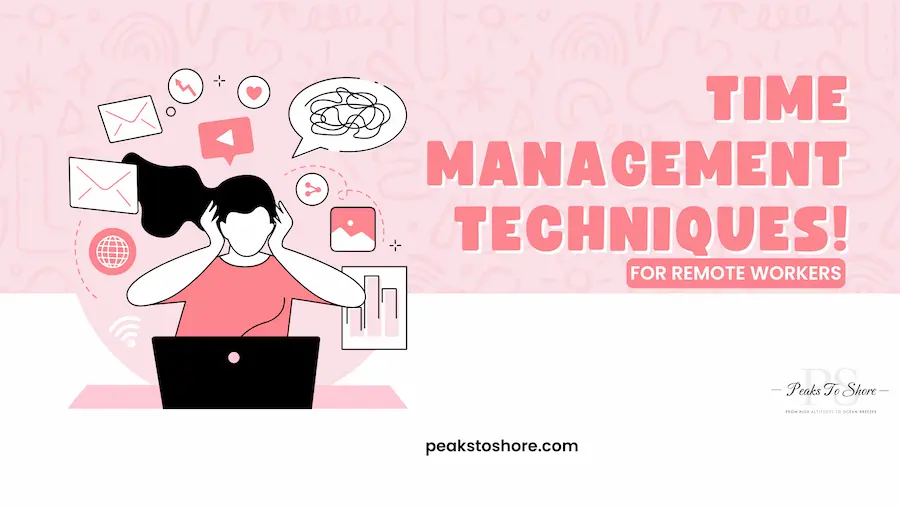Working from a mountain cabin in Slovenia? Or juggling Zoom calls in a Lisbon coworking café? Wherever you are, time management can make or break your remote lifestyle.
Remote work offers incredible freedom—no commute, flexible hours, and the chance to design your day your way. But with that freedom comes a hidden challenge: managing your time without the structure of an office or a manager breathing down your neck.
This guide is for anyone navigating the remote lifestyle—whether you’re a digital nomad bouncing across Europe, an expat adapting to a new country, or someone simply enjoying the perks (and pitfalls) of working from home. We’ll dive into six battle-tested techniques that not only help you stay productive but also leave space for what matters—adventure, rest, and balance.
👉 Already dreaming of remote work in a peaceful town? Discover Best Cities with Co-Working Spaces and Fast WiFi in Europe
1. Setting Up Your Remote Workspace
A well-organized workspace is the foundation of a productive day. Without a clear separation between work and relaxation, it’s easy to lose focus or feel unmotivated.
💡 Why It Matters
Working in a noisy or cluttered space—like a busy café or shared kitchen—can lead to constant distractions. A dedicated workspace signals to your brain that it’s time to focus, improving productivity and reducing stress.
🛠️ How to Do It
- Choose a Quiet Area: Find a spot away from distractions—a spare room, corner of your apartment, or balcony with a view.
- Equip Yourself: Invest in a good chair, lighting, and internet (minimum 20 Mbps for video calls).
- Reduce Distractions: Use noise-canceling headphones, block apps with Freedom, and keep your phone in another room during focus time.
Tip: Test your internet speed with Speedtest.net before committing to a location.
👀 Considering relocating? See our honest breakdown: Moving to Portugal – The Real Deal Guide.
2. Planning Your Day with Time Blocking
Time blocking involves mapping out your day in chunks, each assigned to a specific task. Think of it as scheduling your focus.
💡 Why It Works
It creates structure, helps you avoid context-switching, and ensures you’re giving attention to the right things.
🛠️ How to Do It
- Use a Calendar: Google Calendar, Notion, or even pen-and-paper works.
- Assign Tasks by Energy Levels: High-focus tasks in the morning; admin in the afternoon.
- Include Breaks: Don’t forget 15-minute pauses to recharge.
Tool tip: Try Toggl to monitor your task durations and analyze where your time goes.
3. Mastering the Pomodoro Technique
The Pomodoro Technique helps keep distractions at bay by creating a short-term deadline.
💡 Why It Matters
Short sprints of deep work reduce mental fatigue and make overwhelming tasks more manageable.
🛠️ How to Do It
- Work for 25 minutes, break for 5 minutes. After 4 rounds, take a longer 15–30 min break.
- Adjust based on task size. Writing? Go 50/10.
- Use Focus Booster or Pomofocus.
🌲 Imagine applying this from a lakeside cabin in Denmark. Curious what life there is like? Here’s what they don’t tell you about moving to Denmark.
4. Leveraging Technology Tools
From automation to scheduling, the right tools make a world of difference.
💡 Why It Works
It eliminates mental clutter and reduces repetitive tasks so you can focus on what matters.
🛠️ How to Do It
- Project Management: Use Trello or Asana.
- Automation: Set up Zapier to handle repetitive work like sending Slack reminders or auto-saving files.
- File Organization: Integrate Google Drive and Slack for smoother collaboration.
5. Setting Boundaries and Saying No
Your time is valuable. Without office walls, others may assume you’re available 24/7. It’s up to you to protect your schedule.
💡 Why It Matters
Burnout happens when you work long hours without breaks or boundaries.
🛠️ How to Do It
- Define work hours (e.g. 9–5) and stick to them.
- Use Slack status updates and auto-replies like: “I’ll get back to you during office hours.”
- Practice saying no: “I’m at capacity this week. Can we revisit next month?”
🚫 Need a reality check on expat burnout? Here’s why some say Portugal is paradise—and why others don’t.
6. Embracing Flexibility with a Routine
Routines don’t have to be rigid. A flexible rhythm keeps you focused without sacrificing freedom.
💡 Why It Matters
It helps ground your day, especially while traveling or adjusting to time zones.
🛠️ How to Do It
- Morning Ritual: Stretch, journal, plan your MITs (most important tasks).
- End-of-Day Reflection: Note what went well and prep tomorrow’s list.
- Gamify habits with Habitica to stay on track.
🌍 Remote Work Travel Tips
- Verify WiFi before booking long stays. Anything under 10 Mbps? Avoid for Zoom-heavy roles.
- Time Zone Planning: Use World Time Buddy to avoid overlap chaos.
- Carry a Portable Charger: Keep your tech ready while hopping cafés or trains.
- Backup SIM Card: Always carry a data SIM in case of outages.
❓ FAQs: Time Management for Remote Workers
Q: How do I stay motivated when working alone?
Break tasks into small wins and reward yourself. Even 15 minutes of focus can lead to a flow state.
Q: What if my internet fails mid-meeting?
Have a 4G hotspot or local SIM card. Make sure your calendar buffer accounts for delays.
Q: How do I manage a team across time zones?
Rotate meeting times and use async tools like Loom, Notion, and Slack threads to cut down on calls.
Q: What if I want to travel full-time and work?
You can! Just make sure you have a remote-friendly job, a visa plan (like Portugal’s D7), and good time habits.
✅ Final Thoughts: Make Time Your Ally
Time is your most valuable resource—especially when you’re working from dreamy destinations across Europe. By setting up the right environment, choosing smart techniques, and staying mindful of your energy, you can work better… not just longer.
Which tip will you try first? Or do you already have a remote work rhythm that works wonders?
👇 Drop your thoughts in the comments below or share this post with your remote team!






I liked the examples you used, they made the topic easier to understand.